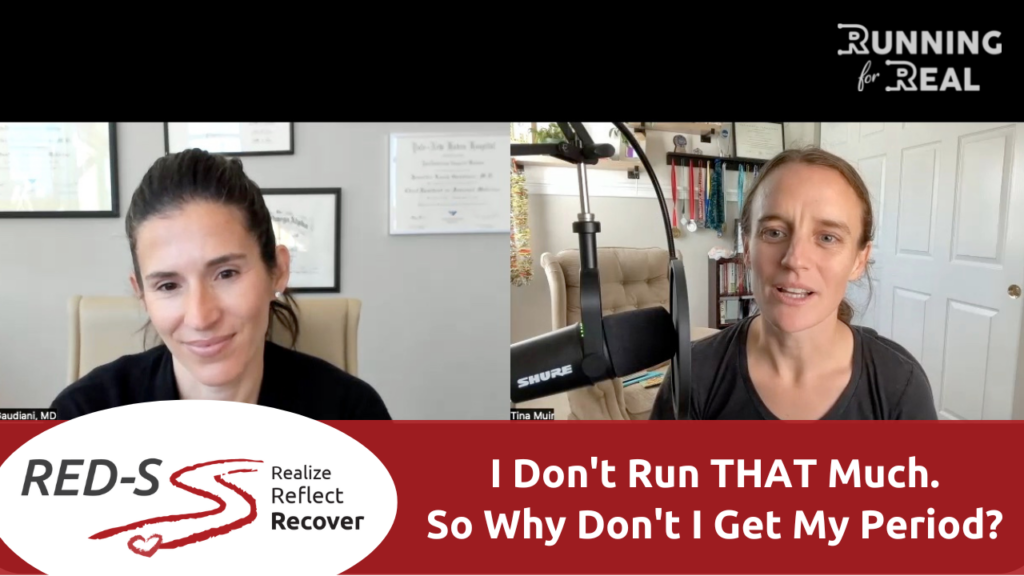You’ve stopped having your period, but why? There are several reasons why someone may not be menstruating properly.
If somebody has inadequate fueling and possibly other symptoms of RED-S / REDs (Relative Energy Deficiency in Sport,) then it may well be hypothalamic hypogonadism. Another option is polycystic ovarian syndrome (PCOS). Dr. Jennifer Gaudiani explains what blood tests to have and what markers to look for in both of these instances.
A useful tool for diagnosing PCOS is the Free Androgen Index (FAI). The tests you need for that are testosterone level and sex hormone-binding globulin (SHPG). The equation for the FAI is testosterone level times 3.47 divided by SHPG. If the resulting number is greater than four, that is an elevated FAI and is suggestive of polycystic ovarian syndrome.
Another potential cause of amenorrhea is Mast Cell Activation Syndrome, an allergic response that may result in a lower energy state due to food intolerances, and thus cause irregular periods. Dr. Gaudiani has a blog post series on her website where you can learn more about MCAS:
https://www.gaudianiclinic.com/gaudiani-clinic-blog/2022/7/21/mast-cell-activation-syndrome-mcas-amp-eating-disorders-part-one-what-is-mcas-and-why-should-people-with-eating-disorders-care
https://www.gaudianiclinic.com/gaudiani-clinic-blog
Read the transcript
[Tina] How do I know if it’s PCOS or RED-S or amenorrhea?
[Jen] Oh, such a good question. It’s gonna take some time. There’s not a magic wand that’s going to easily distinguish among them, so just knowing to ask that question is the first step. Knowing that not all causes of irregular or absent periods are the same cause allows you to advocate for yourself within the system, and really ask that medical practitioners not make a snap judgment or an over-hasty determination, because medical practitioners will do that. And really ask them. I want you to think deeply about this. I want to push you on this, because it matters. It matters for your health, your body, and your performance.
So there are a lot of reasons why somebody might not be menstruating properly. If somebody has inadequate fueling and they’ve got possibly other symptoms of RED-S, then it’s reasonable to think, “All right, this is secondary amenorrhea due to hypothalamic hypogonadism, where the brain turns off the production of adequate sex hormones and therefore menstruation gets irregular or actually stops.
The easiest way to check for that is to have a spot estradiol level checked in the blood. If the estradiol level is checked and it’s less than 50, you’re pretty much done. This is RED-D causing hypothalamic amenorrhea. And then the solution for that is rest, nourishment, re-equipping your body to be able to do what it needs to do.
However, if your estradiol level is normal and the periods are still irregular or absent, we need to think about a few other possible options, and one of them may be polycystic ovarian syndrome or PCOS, which I am not an expert in but know essentials about. And PCOS has a complicated rap because it’s often associated with a series of other medical conditions like insulin resistance, and it may also be associated with people who are in a larger body size. So for athletes who are in a larger body size, unfortunately the innate size stigma in the medical field may lead a practitioner to make an assumption, “Oh yep, larger body size, irregular periods, this must be PCOS.” Maybe, but it has to be challenged and evaluated and I really like using an equation that I learned from a dear expert friend of mine and it’s called the Free Androgen Index, and I’ll let you know about it so that you all can actually advocate with your healthcare providers for it.
Here’s the equation: testosterone level times 3.47 divided by sex hormone-binding globulin. So the tests you need to have checked there are the testosterone level and the sex hormone-binding globulin or SHPG. When you do that equation, if the number is greater than four, that’s an elevated Free Androgen Index and that is more suggestive of polycystic ovarian syndrome. That doesn’t necessarily make the diagnosis, of course; it’s just one piece, but it’s something to think about.
I also really think about a process that I manage a lot that’s called Mast Cell Activation Syndrome, in which people have sort of an abnormal allergic response to the world. It’s very, very prevalent in as many as 17 percent of the population and it frequently causes irregular periods, as well as cysts on the ovaries. So many times I’ve cared for patients who get Mast Cell Activation Syndrome; might, as a result of food intolerances, get into a lower energy state and have abnormal periods, but their estradiol level is normal and as it turns out, when we treat the Mast Cell, the periods come back perfectly regularly. And I’ve had people who have been erroneously diagnosed with hypothalamic amenorrhea and people erroneously diagnosed with PCOS, who actually have Mast Cell Activation Syndrome, so we want to keep that in the mix, as well.
[Tina] Would you say that it’s best to just get yourself this blood work with requesting those specific markers you mentioned and figure this out, or is there a specific expert in those, or a specific type of certification or expert you would recommend going to find?
[Jen] I think for an initial assessment, going to one’s primary care provider or gynecologist is really reasonable, saying, “Look, here’s what’s going on. My periods are irregular / absent; I’d like to begin a thoughtful workup of this” and anyone who doesn’t have to have expertise in RED-S can actually do that. However, if numbers are unsure, or if the provider feels unsure, or if the individual is like, “Something just doesn’t feel quite right,” seeking out an endocrinologist, seeking out an eating disorder professional, even if the cause is not fundamentally an eating disorder, we do know a lot about the ravages of malnutrition. And /or reading up on processes like Mast Cell Activation Syndrome, which I have a blog series on on our clinic website about eating disorders and MCAS, those can really help to educate an individual to know where to go next.
[Tina] Okay, thank you, and I will put links below this video to go check out that blog post you mentioned and then put the equation in there, as well. Thank you.
check it out
Recovering from RED-S is hard. It’s even harder if you’re working through it alone. Even if you have professional support, they’re not available 24-7, and that can lead to going down search engine rabbit holes that have the potential to derail everything.
Our online resource, RED-S: Realize. Reflect. Recover, will answer all those questions swimming around in your head about recovery. It will give you the opportunity to connect with the experts you’ve come to know here, and to surround yourself with a community of others who are going through it too. THANK YOU! to Athletic Greens and Tracksmith for supporting this YouTube series and RED-S: Realize. Reflect. Recover.
Go to athleticgreens.com/reds to get five free travel packs of AG1 and a free one year’s supply of vitamin D3+K2 with your subscription!
When you go to https://tracksmith.com/tina and use the code TINA15 at checkout, you’ll get free shipping and Tracksmith will donate 5% of your order to Rising Hearts, the Indigenous-led nonprofit founded by Jordan Marie Daniels.
more about Dr G:
Dr. Jennifer Gaudiani, CEDS-S, FAED, is an internist who specializes in eating disorders. She practices from a deeply anti-diet, weight-inclusive perspective and partners with therapists and dietitians around the country to ameliorate medical roadblocks in patients’ recovery journeys. Her book, “Sick Enough: A Guide to the Medical Complications of Eating Disorders,” is for patients, families, and practitioners. You can find Jen at https://gaudianiclinic.com




